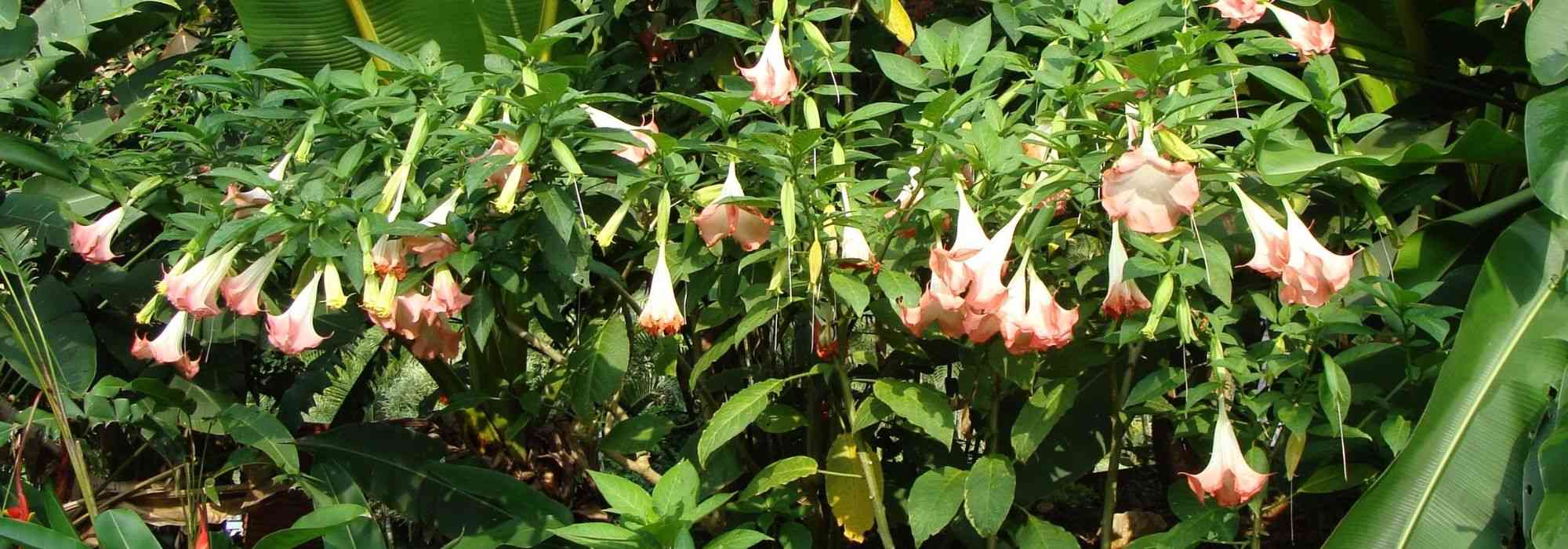
Datura and Brugmansia: sowing, planting, and caring for them
Contents
Datura, in a nutshell
- There are two types of Datura: the arborescent variety, whose true name is Brugmansia, often grown in pots, and the annual or perennial herbaceous Datura that is commonly sown.
- They produce large, pendulous or upright trumpet-shaped flowers, which are very spectacular and fragrant during the summer.
- With a very rapid growth, the arborescent forms are quite impressive in size, even if they completely resurge from the soil after a slightly cold winter.
- These plants, easy to grow even in poor and polluted soil, have a high toxicity if ingested, which should be taken into account if you have young children.
A word from our expert
Daturas, sometimes referred to as “Angel’s Trumpet”, encompass two types of plants, arborescent and herbaceous, belonging to the Solanaceae family, just like Tomato, Pepper, and Belladonna. The former form small, highly ramified trees or large bushes ranging from 2 to 6 m, evergreen or semi-evergreen, highly valued in summer for their long, pendulous, fragrant flowers in white, golden yellow, or reddish-orange that bloom in the evening. The latter are short-lived herbaceous forms that can resprout from the stump for a few years if protected with a thick mulch. They are ideal plants for filling a bed in poor, light, sandy, or loamy soil in record time.
Aside from their herbaceous nature, Datura can be distinguished from Brugmansia by their upright or horizontally positioned, smaller flowers, as well as their spiny fruits.
Daturas, in a broad sense, are generous in foliage, flowering, and nocturnal fragrances, which explains the enthusiasm for this type of tropical-looking plant despite their notorious toxicity (similar to that of Oleander). The flowering is very spectacular between July and October. However, in open ground, the flowering of Brugmansia often starts late in the season, around the end of summer, when the stems have had to fully regenerate after a frost. It is therefore preferable to grow it in a pot to shelter it in winter and advance its flowering. You will be charmed by the powerful, slightly narcotic scent of its flowers when evening falls. Herbaceous Daturas, being less demanding in water, have the advantage of growing very quickly from seeds even in poor soil. Beware all parts of the plant are toxic. Avoid mixing them with vegetable plants and placing them within reach of young children. The wild species, Datura stramonium (Common Thorn Apple or Devil’s Herb), is also beautiful in flower but is particularly toxic and requires strict precautions (gloves and mask) for its removal.
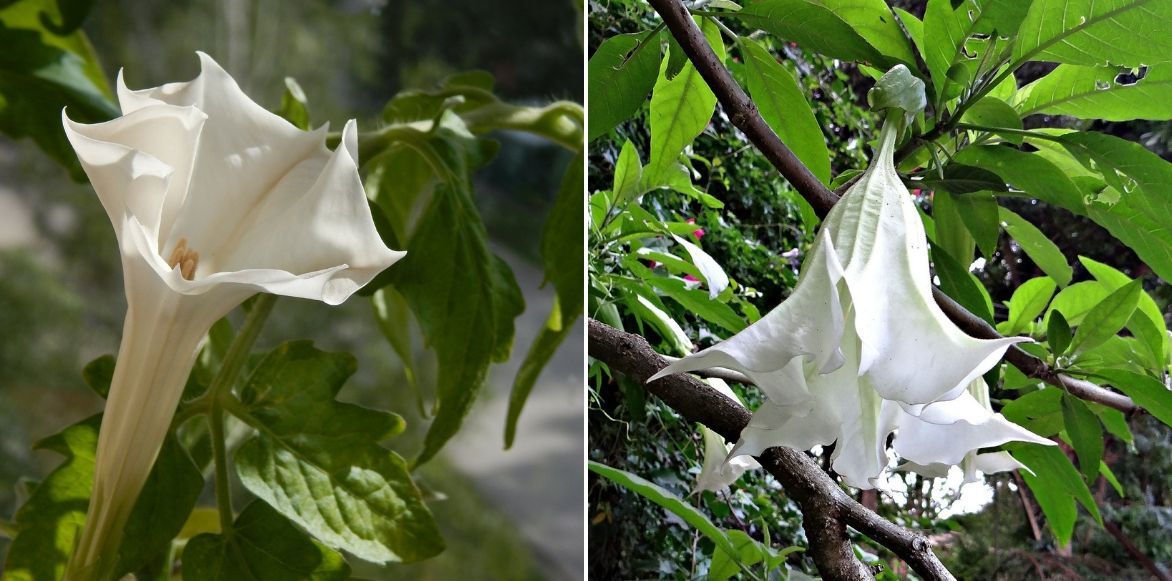
Datura (herbaceous, upright trumpet-shaped flower) and Brugmansia (arborescent, pendulous trumpet)
Description and Botany
“`html
[plant_sheet latin_name=”Latin name: Datura, Brugmansia” family=”Family: Solanaceae” common_names=”Common name: Datura, Devil’s Herb, Angel’s Trumpets” flowering=”Flowering: from July to October” height=”Height: between 0.50 and 5 m” exposure=”Exposure: sun or partial shade” soil=”Soil: ordinary to rich well-drained soil, even calcareous” hardiness=”Hardiness: Low (0 to -7 °C)” bgcolor=”#d6d47a” alignment=”left” /]
The Brugmansia or arborescent daturas are plants from Central and South America, while the genus Datura in the strict sense is found in tropical, subtropical, and warm temperate regions of America, as well as in Asia (Southern China), Africa, Europe, and Australia. The former includes 6 species distinguished by large pendulous flowers, non-spiny fruits (rare in cultivation), and a long lifespan of several decades. With thick, sparsely branched stems, they can reach 5-6 m in height and 2-3 m in width in humid and warm conditions if not pruned back by frost each year. The latter, herbaceous types, retain the scientific name Datura and include 12 species. These non-woody perennials with a short lifespan easily regrow in mild climates from a tuberous root and form a bush 1 m to 1.50 m in all directions within 2-3 months.
Daturas are burdened with many vernacular names that warrant caution: Devil’s Herb, Angel’s Trumpet, Trumpet of Judgment Day, Trumpet of Fools, Thorny Apple… It is true that the family of daturas includes species that are extremely toxic (narcotic and poisonous), even by simple contact, particularly the Common Jimsonweed.
Datura stramonium is an annual species of American origin that is increasingly found in France in floodplains downstream from large urban areas. It is recognizable by its upright white trumpet-shaped flowers and its very spiny green fruits, which turn beige and are about 5 cm in diameter. Its spontaneous presence often indicates that the soil is polluted, whether by urban, industrial, or agricultural pollution induced by the presence of pesticides or fertilizers, or by an excessive presence of salts (compacted soils in coastal regions or excessively irrigated areas).
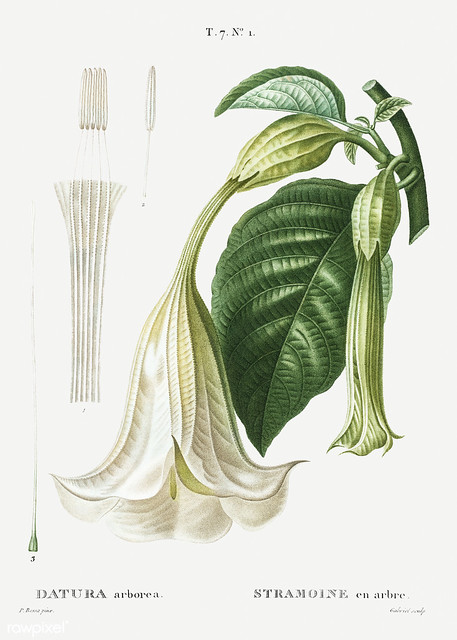
Brugmansia arborea – botanical illustration
It is strongly recommended not to touch it and to wear gloves and a mask if you need to uproot it due to its narcotic content. Note that honey obtained from the foraging of Datura stramonium can cause poisoning, as can the fumes generated by burning the plant. In contrast, the species Datura innoxia (syn. Datura meteloides) and Datura metel sold as seeds for ornamental gardens are less poisonous, as the name innoxia, meaning “harmless,” indicates, although caution is still advised, as with Brugmansia.
Brugmansia and Datura belong to the Solanaceae family, just like Tomatoes, Tobacco, Potatoes, as well as Belladonna and Mandrake, which are referred to as witch plants due to their toxicity.
The foliage, about twenty centimeters long, is alternate and deciduous in our climates. In Brugmansia, the light green, velvety, and soft lamina is oval-shaped with smooth edges in adult leaves, bearing a few teeth in juvenile form. In Datura, the leaves are entire or angular-edged with a very veined and often crinkled dark green lamina, more or less bluish, borne on branched stems often tinged with purple or blackish red. They measure between 5 and 20 cm long and 4 to 15 cm wide. The foliage has a foul odour when touched. There are cultivars with variegated forms. The two species marketed for ornamentation, Datura innoxia and Datura metel, closely resemble each other but differ in the number of secondary veins branching from the central vein of each leaf.
The flowers are generally numerous but solitary, arising from a large pale green elongated bud that splits down the middle. The corolla, with 5 fused petals forming a funnel that widens to reach 18 cm in diameter and 30 cm long in hybrid Brugmansia, varies in colour from pure white to light pink, passing through pale golden yellow as seen in Brugmansia arborea, bright orange in B. sanguinea, and intense purple sometimes mixed with white in Datura metel. The petals are marked with a central vein and end in a curved tip, giving the flower a horned trumpet appearance. In double-flowered varieties, the blooming of the flowers is very spectacular as the spiralled petals unfurl. The corolla is preceded by a fused calyx forming a greenish tube or a collar (Datura innoxia). The sweet fragrance that emanates from the flowers of daturas in the evening and during the night has earned them the name “angel’s trumpet.” Their flowers are heavily visited by foraging insects such as moths, hummingbirds, and bats.
The spherical capsules of herbaceous Daturas are remarkable for their spiny surface (non-spiny when the fruit is still green), which has earned them the nickname “thorny apple” or “stinking chestnut.” As they dry, the fruits change from green to beige and then split open to release black seeds about 2 mm in size. In Brugmansia, the fruits are smooth and fleshy, sometimes very long and thin. It is rare to see these fruits in cultivation here, especially since many infertile hybrids are grown. Brugmansia arborea is the only self-fertile species capable of producing fruits here.

Evolution of a Datura flower
The Datura metel and Datura innoxia are medicinal plants at low doses (for rheumatism, anti-inflammatory…), but are mainly known for their hallucinogenic effects, used during ritual ceremonies by the Aztec and Navajo peoples in North America (D. innoxia) and in India (D. metel).
“`
The main varieties of Datura
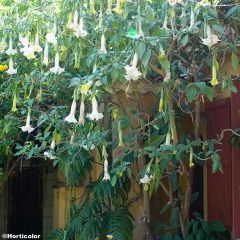
Brugmansia arborea
- Flowering time August to December
- Height at maturity 2 m
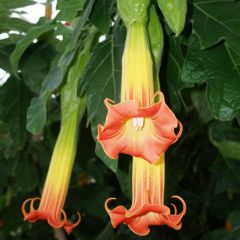
Brugmansia sanguinea - Red Angel's Trumpet
- Flowering time July to November
- Height at maturity 2 m
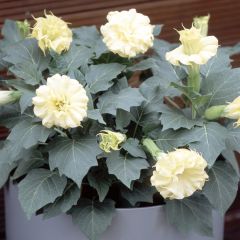
Datura metel Double Golden Queen Seeds - Brugmansia
- Flowering time August to November
- Height at maturity 1,40 m
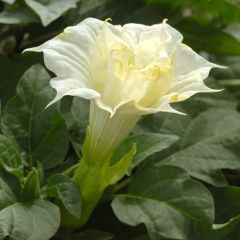
Datura metel Double White Lady Seeds - Brugmansia
- Flowering time August to November
- Height at maturity 80 cm
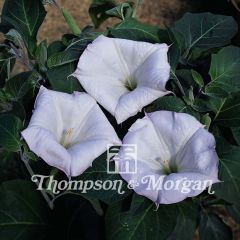
Datura metel Evening Fragrance Seeds - Brugmansia
- Flowering time August to November
- Height at maturity 1 m
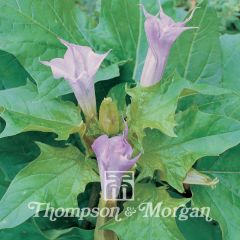
Datura meteloides La Fleur Lilac Seeds - Brugmansia
- Flowering time August to November
- Height at maturity 45 cm
Discover other Datura seeds
View all →Available in 1 sizes
Available in 1 sizes
Available in 1 sizes
Available in 1 sizes
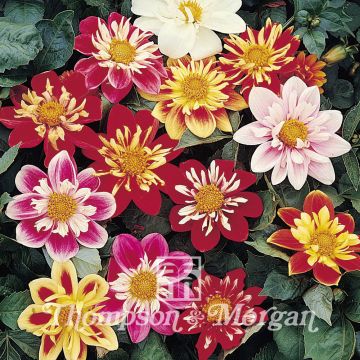
Available in 1 sizes

Available in 1 sizes
Available in 1 sizes
Planting
Where to Plant Datura?
To plant a Brugmansia in the ground, a mild climate is essential, such as that found around the Mediterranean or along the Atlantic coast. Choose a warm, sunny location sheltered from cold and wind. Brugmansia require a rich, deep soil that is well-watered in summer. However, the soil must be well-drained to help the stump withstand frost (maximum -7°C for Brugmansia sanguinea, known to be the hardiest of the Brugmansia). You can easily grow Brugmansia in a large pot with a diameter of 40 to 50 cm, which can produce plants up to 1.40 m in all directions by the end of the season.
Herbaceous Datura can be sown on a well-sunny bank north of the Loire or in partial shade in the south, in ordinary soil that has been recently turned, even calcareous and dry in summer if it is deep enough. They can help to cleanse polluted soil, colonise fallow land, and the edges of roads. The plant produces a tuberous root that is sensitive to frost and excess water. You can protect the stump with mulch to encourage regrowth the following year or reseed in spring. This plant is hardy in zone 9 (0 to -7°C).
When to Plant?
Plant or sow Daturas in spring as they need warmth to develop.
How to Plant?
This plant is very easy to grow, whether it is Brugmansia or Datura, although the requirements differ.
Brugmansia aurea, arborea, x candida…
- Soak the pot of Brugmansia in a bucket of water to thoroughly moisten it and untangle the roots if they have started to circle the pot.
- Dig a wide hole at least three times wider than the root ball and up to 50 cm deep.
- Add a few shovelfuls of compost or well-rotted manure, or one to two handfuls of organic fertiliser to the soil. In pots, choose a good potting mix for geraniums, ensuring to place gravel or clay balls at the bottom of the pot to a depth of 5 cm.
- Place the plant in the planting hole.
- Replace the soil and lightly firm it down.
- Water generously and then mulch.
Datura metel, innoxia (meteloides)…
You can grow Datura as a perennial by either purchasing young plants or sowing seeds yourself (see Sowing). You can also cultivate it as an annual, uprooting the plant at the end of summer, either in a container or in the ground.
- Work the soil deeply as the plant prefers disturbed soils.
- Level the area and then dig a hole the size of the root ball.
In pots, create a mix of 2/3 good potting soil to 1/3 river sand for Brugmansias, and 50% potting soil to 50% sand for Daturas.
Datura and Brugmansia Care
- Water Brugmansia generously, as its lush foliage consumes a lot of water. Don’t hesitate to add flowering plant fertiliser if the plant is in a pot.
- You can winter Brugmansia in a moderately warm conservatory between 10 and 15°C or even higher to extend its flowering. If space is limited, a dark room (garage, cellar…) protected from frost is also suitable: the leaves will fall, and you can reduce the branches. The young plant can regrow from the ground if the stems have frozen.
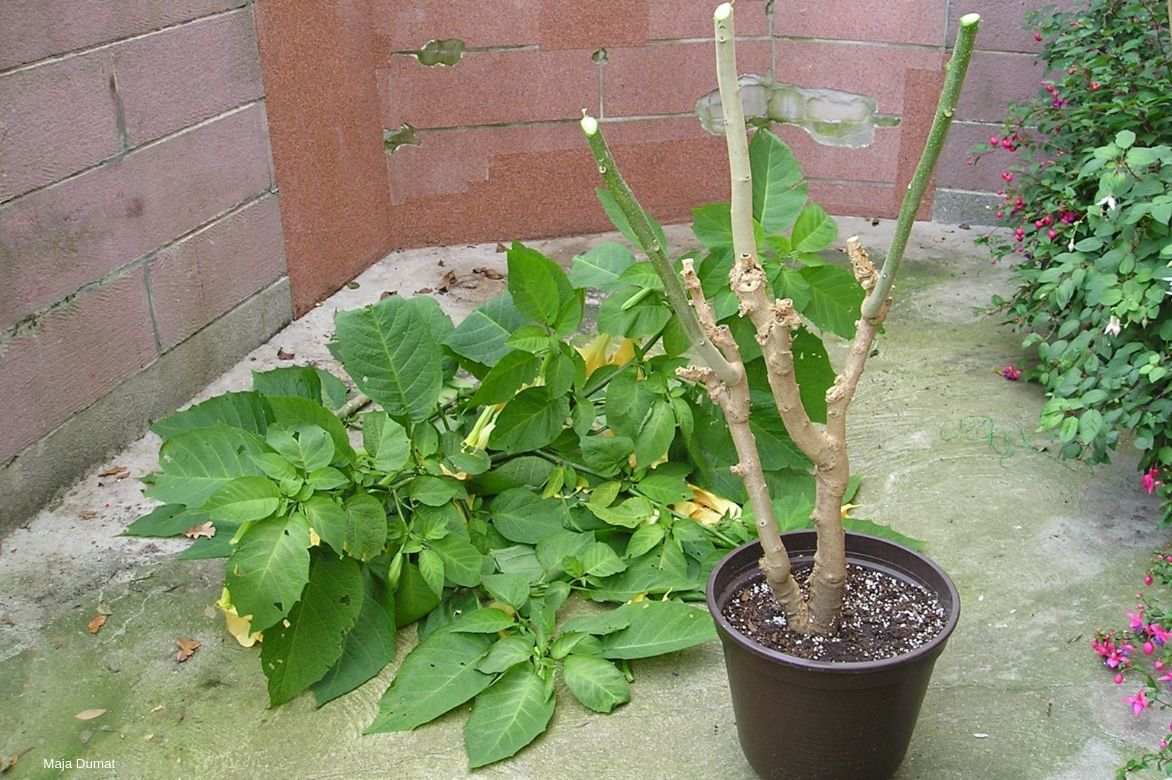
It is possible to reduce the branches before wintering your Brugmansia
- Repot it in autumn or spring into a larger pot, or simply change the surface soil if you are keeping the plant in the same large container.
- Perennial Datura is well adapted to summer drought. Water only if the foliage is completely wilted by the end of the day.
- In winter, protect the stump with a thick mulch that will insulate it from both frost and moisture. Its root is indeed sensitive to excess moisture.
- In pots, watering will need to be frequent.
- Don’t forget to remove the fruits from Daturas before they disperse their seeds to avoid being overwhelmed. Remember to wear gloves and a mask when handling these types of plants. Wash your hands thoroughly after contact.
Multiplication: propagation by cuttings, sowing
The simplest multiplication involves propagating Brugmansia in summer and sowing Datura in February-March.
Propagation by Cuttings
Propagation can be done in a glass of water or in a pot.
- Prepare a deep pot by filling it with potting soil mixed with sand.
- Take cuttings from herbaceous tips about 15 cm long, free of buds or older wood.
- Remove the leaves near the base of the cutting.
- Insert them into the soil for 2/3 of their length, ensuring they do not touch each other.
- Gently firm the soil around to eliminate air pockets and ensure good contact between the potting soil and the cutting.
- Place them in a humid environment in the shade, for example, by covering them with a cut transparent plastic bottle.
- In autumn, separate the rooted cuttings and plant them in pots, keeping them in a greenhouse until spring.
Sowing
Datura seeds can remain in the soil for several years before finding the right conditions for germination.
- Soak Datura seeds in a bowl of lukewarm water for 24 hours.
- Sow in moist potting soil, spacing the seeds 5 cm apart.
- Cover with 5 mm of fine potting soil and lightly firm down with a board.
- Maintain the culture at a temperature of 15 to 20°C in a bright location.
- Germination will take between 21 and 60 days. Growth will be faster afterwards.
- Transplant the seedlings when they reach about 10 cm.
- Water each plant carefully, ensuring no water stagnates in the saucers under the pots.
Flowering occurs in summer, from July to October, approximately 4 months after sowing.
Uses and Associations
Daturas, particularly shrub daturas, are spectacular subjects that are generally placed in isolation in the middle of a lawn or against a sunny wall of the house to enjoy their nocturnal fragrance during summer evenings.
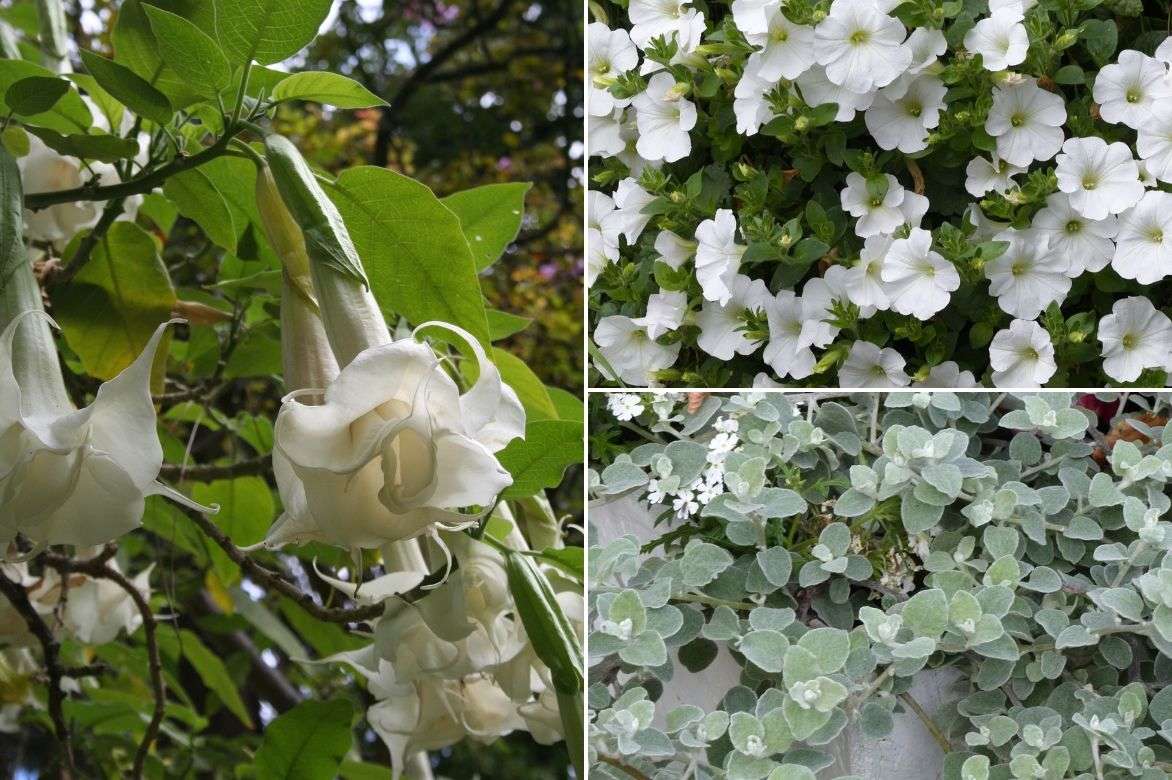
An example of an association in a large pot in the sun: Brugmansia arborea, Petunia Surfinia ‘Snow’, and Helichrysum petiolare at its base
Placed in a container or a large pot, it will stand out on the terrace exposed to full sun with, for example, Mauritanian bindweed (Convolvulus sabatius) or Impatiens to carpet its base. Herbaceous Daturas like Evening Fragrance can enhance the edges of a path alongside Four O’clocks (Mirabilis jalapa), which are also easy to grow as they can regrow from tubercles each year just like Daturas. You can also adorn the base of a small tree such as crape myrtle (Lagerstroemia) or cover a newly installed slope by sowing the seeds broadcast.
For further reading
Discover our range of Datura.
- Subscribe!
- Contents
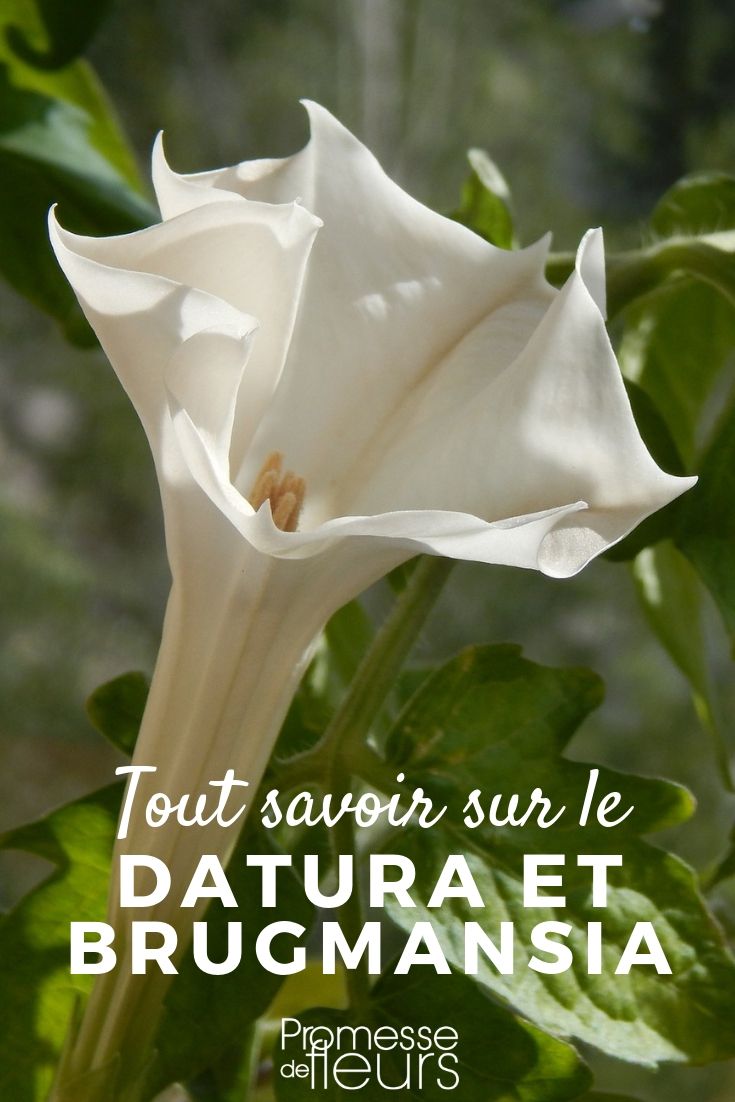


































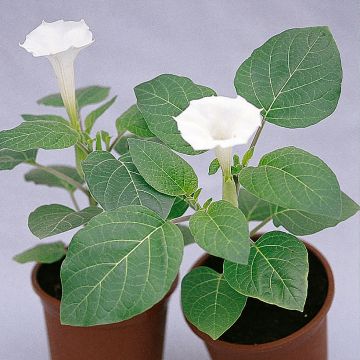

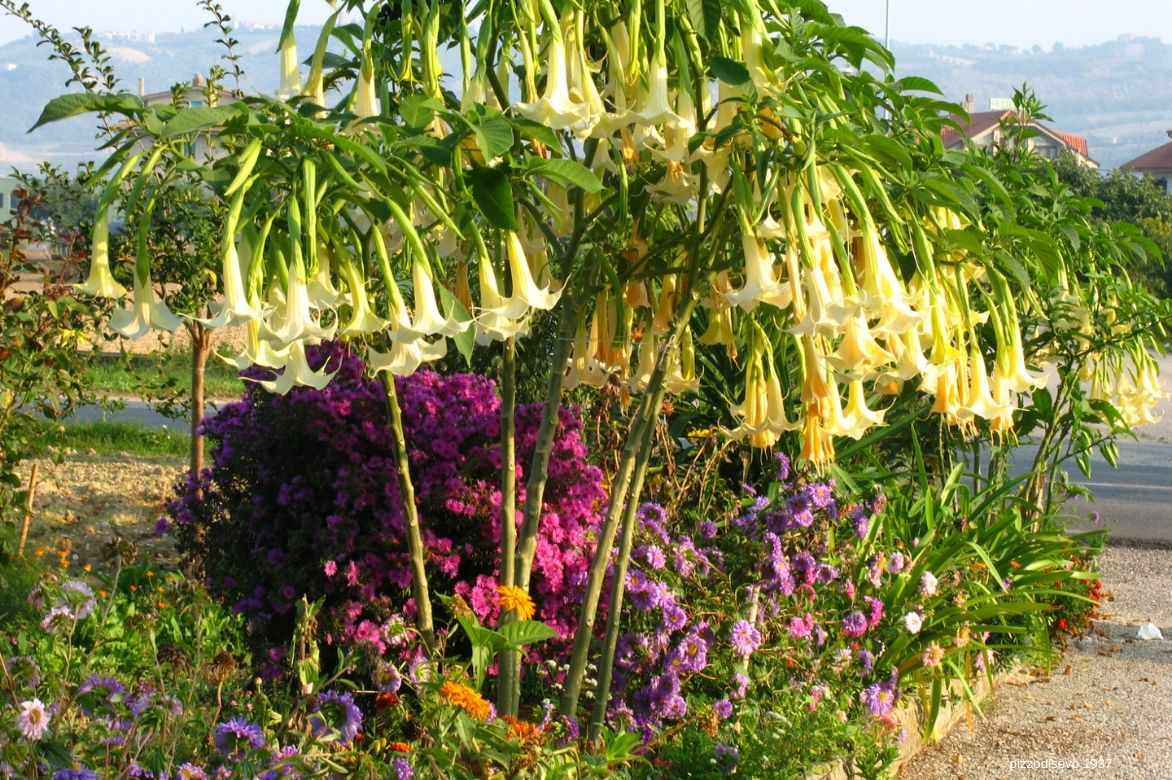
Comments